The following is a basic summary of the control strategy applied to telephone exchange AHU systems.
Application
The following control strategy is applied to AHU systems within a telephone exchange environment where the air is conditioned via cool outside air or DX Cooling before entering the internal space and then returning to the unit to start the process again.
Particular areas to consider with this type of system:
- AHU units may be old and inefficient.
- AHU units may have faults with fans, dampers or cooling etc.
- The number of units in a space may not be sufficient for the capacity of equipment.
- Units can be overridden or powered down locally.
- WEMS allows DX Cooling to run, but the unit decides if it physically enables or not.
- WEMS may not take every possible AHU in an area for whatever reason.
The following strategy covers:
- FP AHU introduction.
- Staging the units for energy savings.
- Fresh air and DX Cooling.
- Energy performance alarming.
- Advanced settings.
The control strategy can change from time to time as WEMS continues to enhance its control strategies either for better environmental control or for energy-saving techniques. Always ensure you have the latest copy of this document.
Control Input/Output Requirements
The WEMS system requires the following inputs and outputs in order to perform the following control strategy. Optional items are indicated by an asterisk (*).
Analogue Inputs
- Outside Air Temp
- Supply Air Temp
- Return Air Temp
- Space temperature
Digital Outputs
- FP AHU Enable
- FP AHU Cool Enable
- FP AHU Pemp Enable
- FP AHU Fan Low Speed Enable
Introduction
The following is a brief explanation of what an FP AHU is with a basic overview of control.
What Is An FP AHU?
An FP AHU is designed for use in telephone exchange environments to help maintain an acceptable temperature in the equipment areas. The equipment in these areas generates a lot of heat and need to be kept at a fairly constant temperature in order to operate correctly.
The FP AHU controls the fans, dampers and DX Cooling of the units in the exchange and will enable each element of the unit based on current internal temperatures in the following order:
- Fan with open damper
- High speed fan
- DX Cooling
All units have a WEMScontroller4 with all four relays configured as above, with supply and return air beads wired into the two analogue terminals.
Staging The Units
To save energy and prolong the life of each unit, WEMS have developed a staging system. There are four different predefined setpoints at which the units will enable. Stage 1 (lead) will enable first based on the internal or return temperatures and Stage 4 (lag) will enable last.
This staging can be programmed into each FP AHU unit at the Channel Setup Wizard stage or at any time by going into the unit's Control Screen and editing the settings in the Advanced Panel.
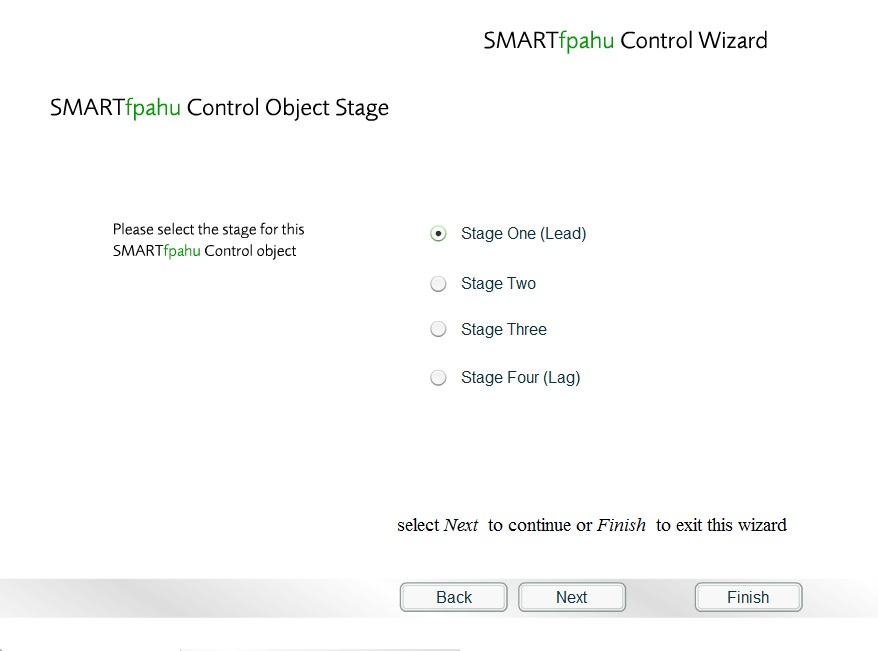
FP AHU being configured in Channel Setup Wizard
Although these stages have predefined setpoints they can also be manually configured. This is to allow different areas with highly sensitive equipment or even areas with very little equipment to be controlled by bespoke settings.
Fresh Air And DX Cooling
One of the biggest expenses to the energy bills of the exchange is when DX Cooling operates. To reduce costs, the system will always try to use fresh air cooling first.
Fresh air cooling is simply allowing the cool air from outside to maintain the space temperature at an acceptable level. This is the cheapest way to cool any building, because fresh air is free and readily available. Therefore, whenever a unit is triggered to operate by the internal temperature, the fan is enabled and dampers are fully opened to allow fresh air into the space.
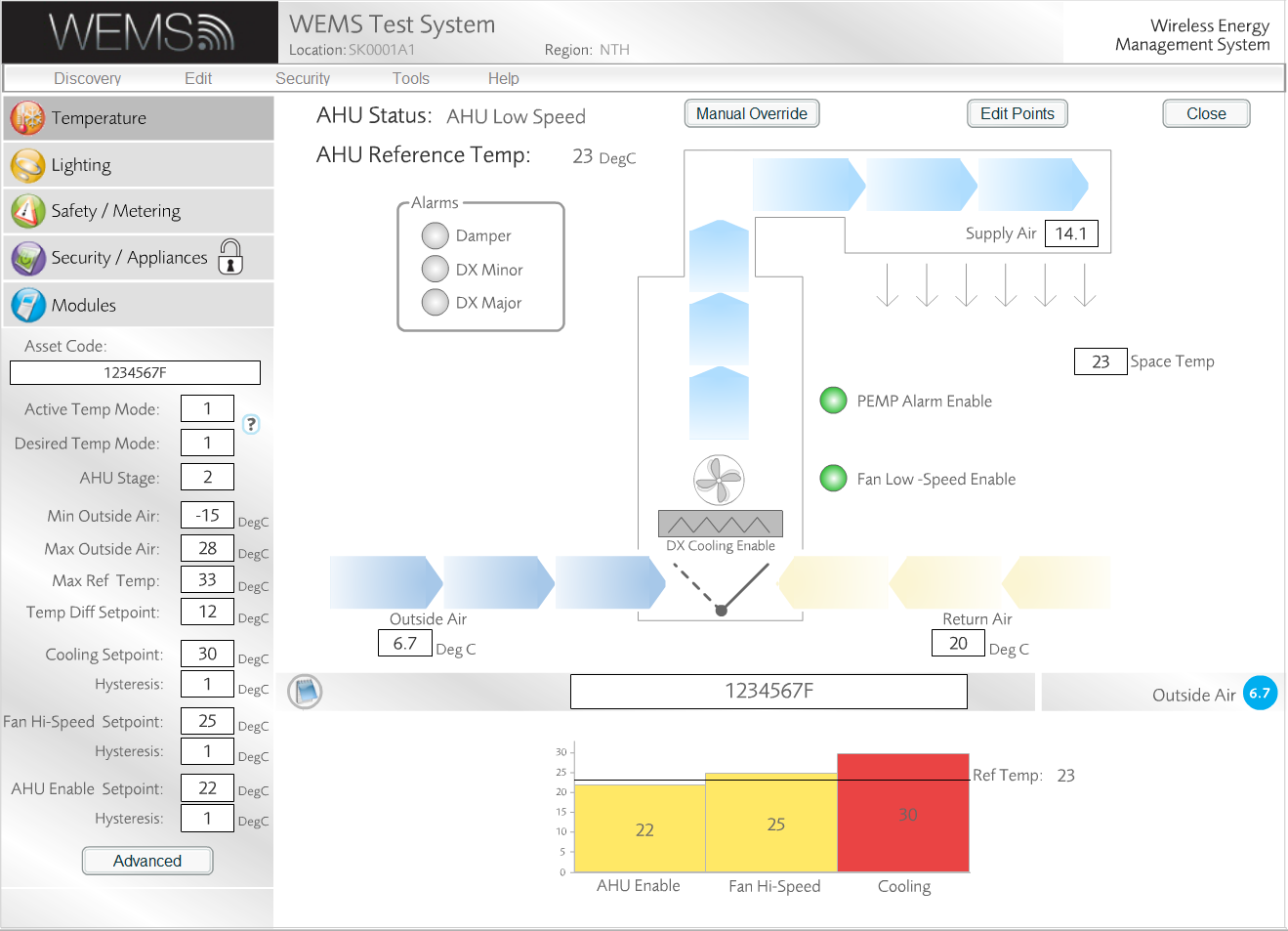
FP AHU Control Screen showing fresh air cooling
In the UK the external air temperature very rarely exceeds 17°C; this strategy works for the majority of the year as all units in that area will attempt to use free fresh air cooling before allowing DX Cooling to operate.
DX Cooling is artificial cooling that will operate when the internal air temperature of the space starts to reach a level that could cause damage to the equipment.
The strategy will allow the cooling to run with a space temperature at around 29–32°C. However, the WEMS strategy does not enable DX Cooling. When relay 2 is enabled the DX Cooling is allowed to run but it is still the original settings of the unit that will physically turn it on. When enabled the FP AHU will keep allowing DX Cooling until the internal temperature starts to come back under control.
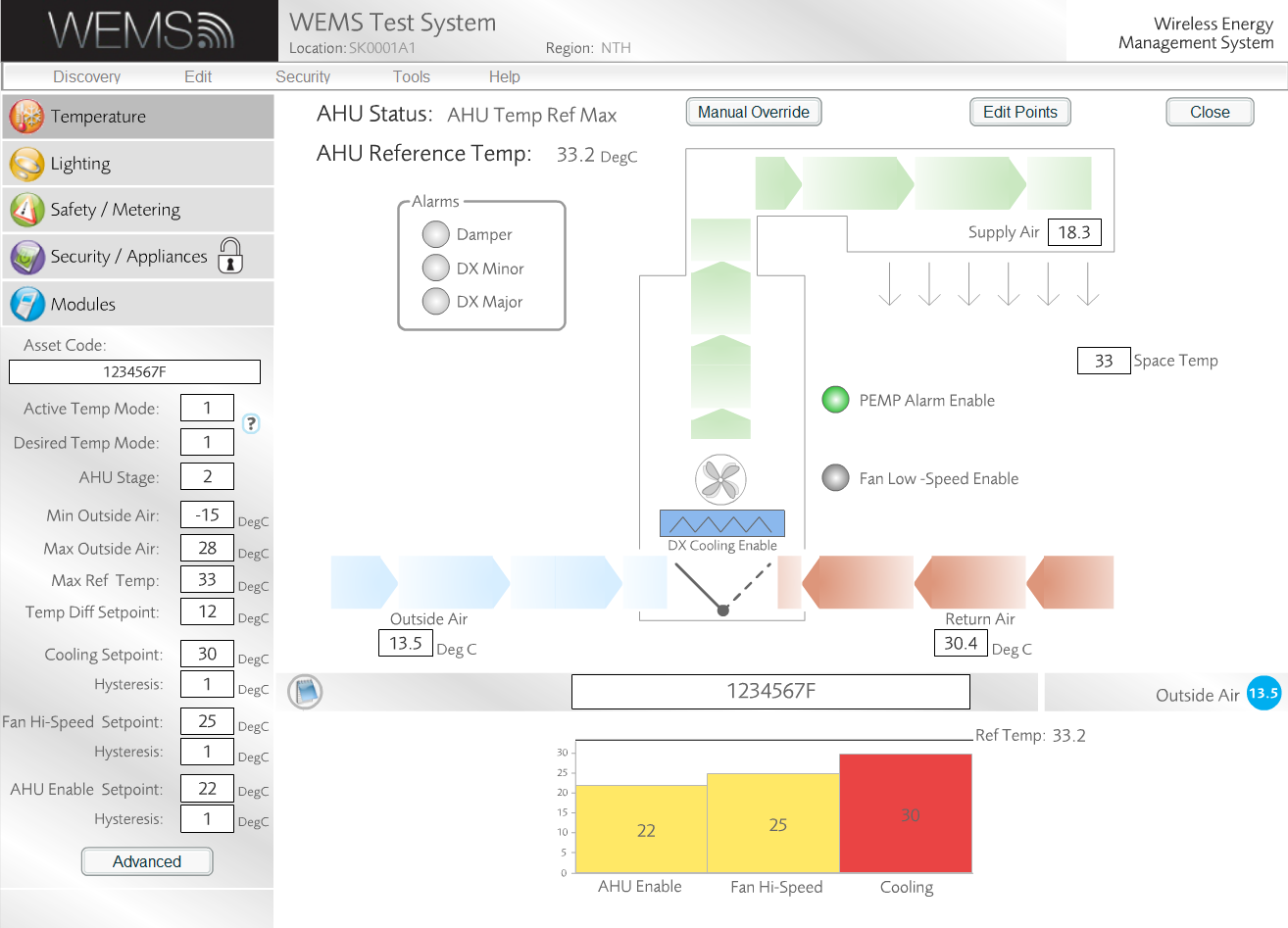
FP AHU Control Screen showing DX Cooling
Energy Performance Alarms
With thousands of telephone exchanges all over the country and even more AHUs the job of maintenance is very important. Not only is it a big job but also it can be very expensive to send out engineers, so targeting the units that need the most attention is key to helping the ongoing performance of the Estate whilst keeping costs down.
Using the temperature data that is part of the control strategy on each unit, the WEMS system will automatically detect potential faults and raise alarms accordingly. These alarms are:
- Damper Alarm
- DX Minor
- DX Major
Each unit can have alarms enabled/disabled by the user and all the thresholds can also be edited either at the Channel Setup Wizard stage or at any time using the settings in the Advanced Panel of each FP AHU.
As well as being highlighted in the user interface, the alarm is sent to SMARTS and to Estate Manager.
Damper Alarm
The system uses Outside Air Temp and Supply Air Temp to judge whether the damper is working correctly. When the unit is in free fresh air cooling mode, the damper should be fully open (100%). Therefore, the Supply Air Temp should be within 10° of the Outside Air Temp. If the difference exceeds this threshold, the unit will display a Damper Alarm. The alarm remains active until the unit sees temperatures that suggest the damper is working correctly.
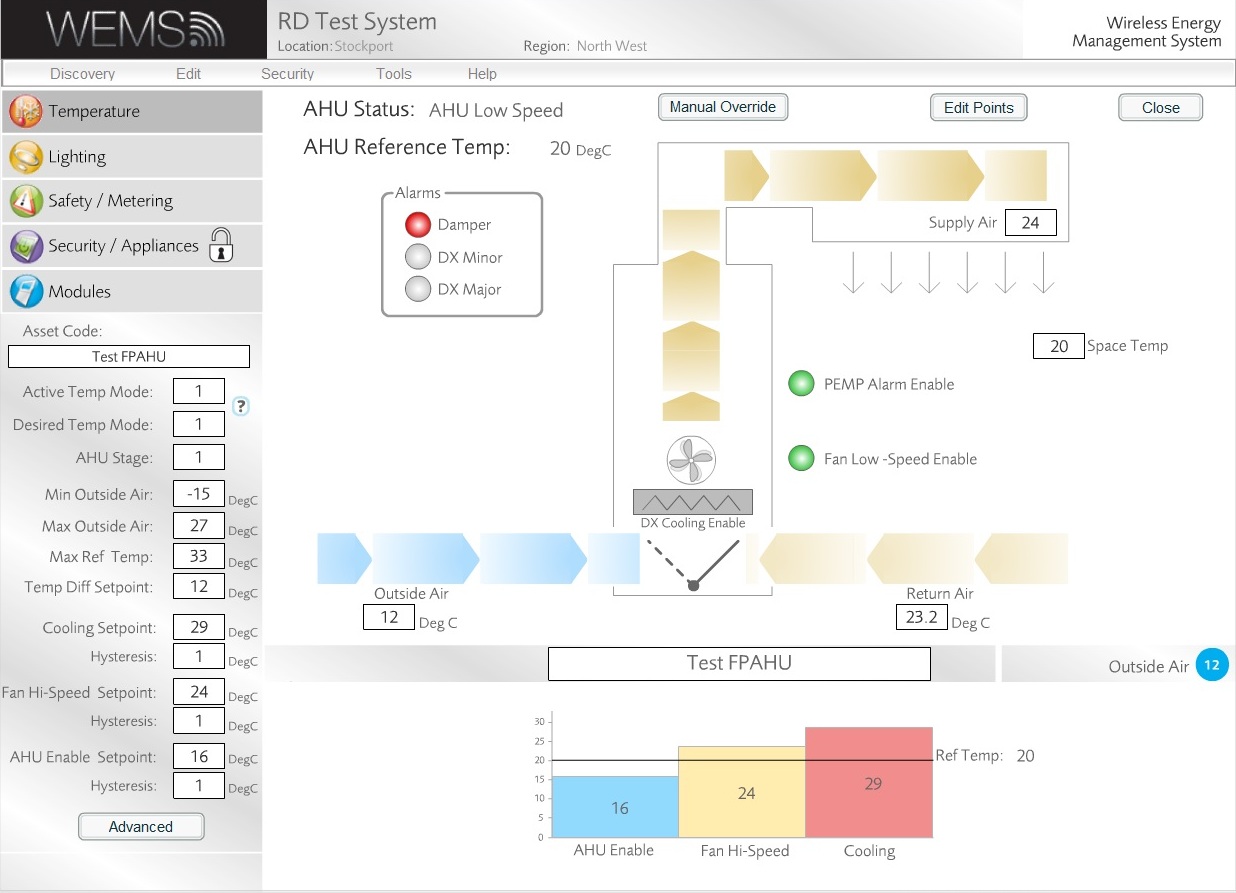
FP AHU with Damper Alarm
DX Alarms
DX Alarms look at the difference between Return Air Temp and Supply Air Temp whenever DX Cooling is enabled. Based on the trial sites and first phase of systems installed, WEMS expect DX Cooling when running to be able to supply air at a temperature 10° lower than what it gets through the return air vent.
DX Minor
If the Supply Air Temp is between 5° and 10° lower than the Return Air Temp then this is considered to be a DX Minor alarm: although performance isn't as expected, there is still some level of cooling from the unit back into the space.
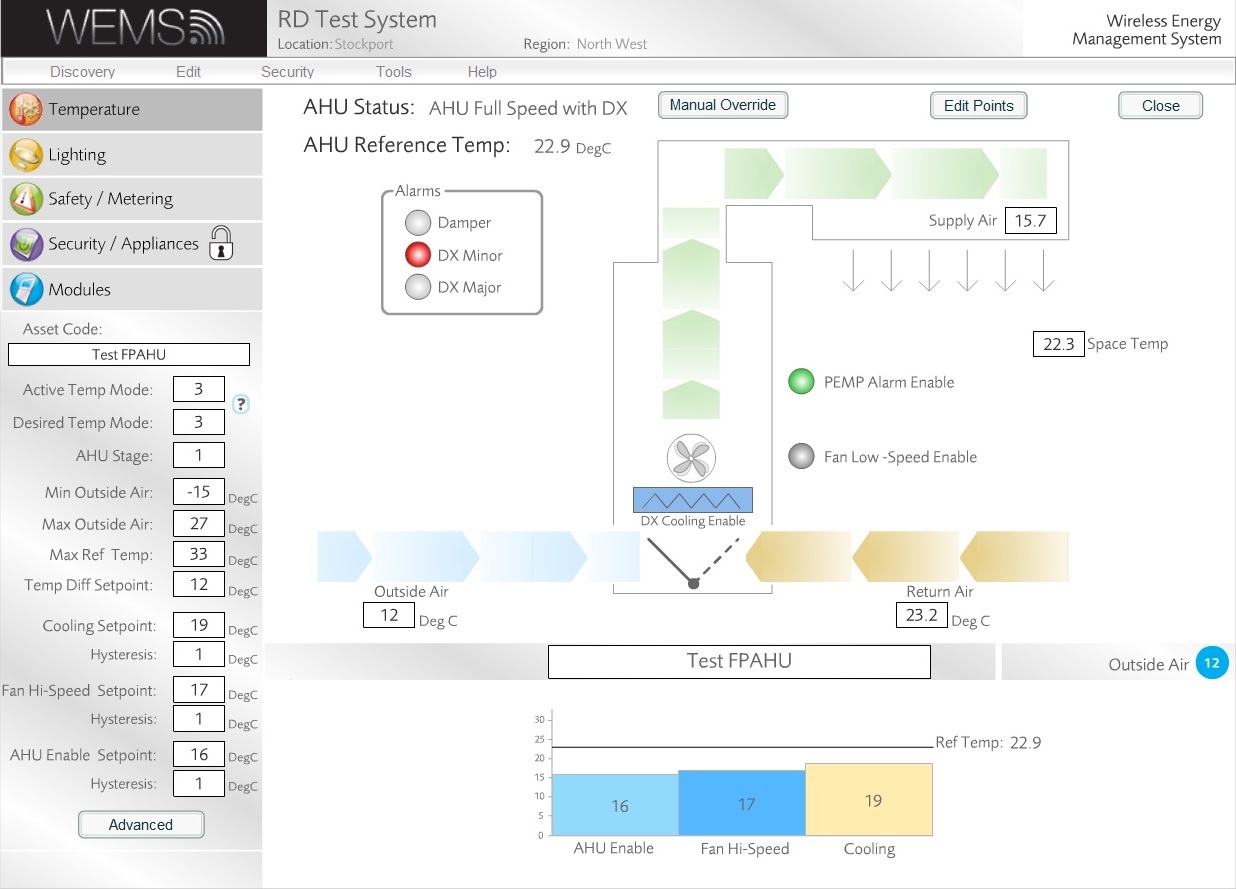
DX Minor alarm
DX Major
If the Supply Air Temp is less than 5° lower than the Return Air Temp then this is considered to be a DX Major alarm, as the cooling appears not to be running/working correctly. The unit may need attention from an engineer to check it is performing as expected.
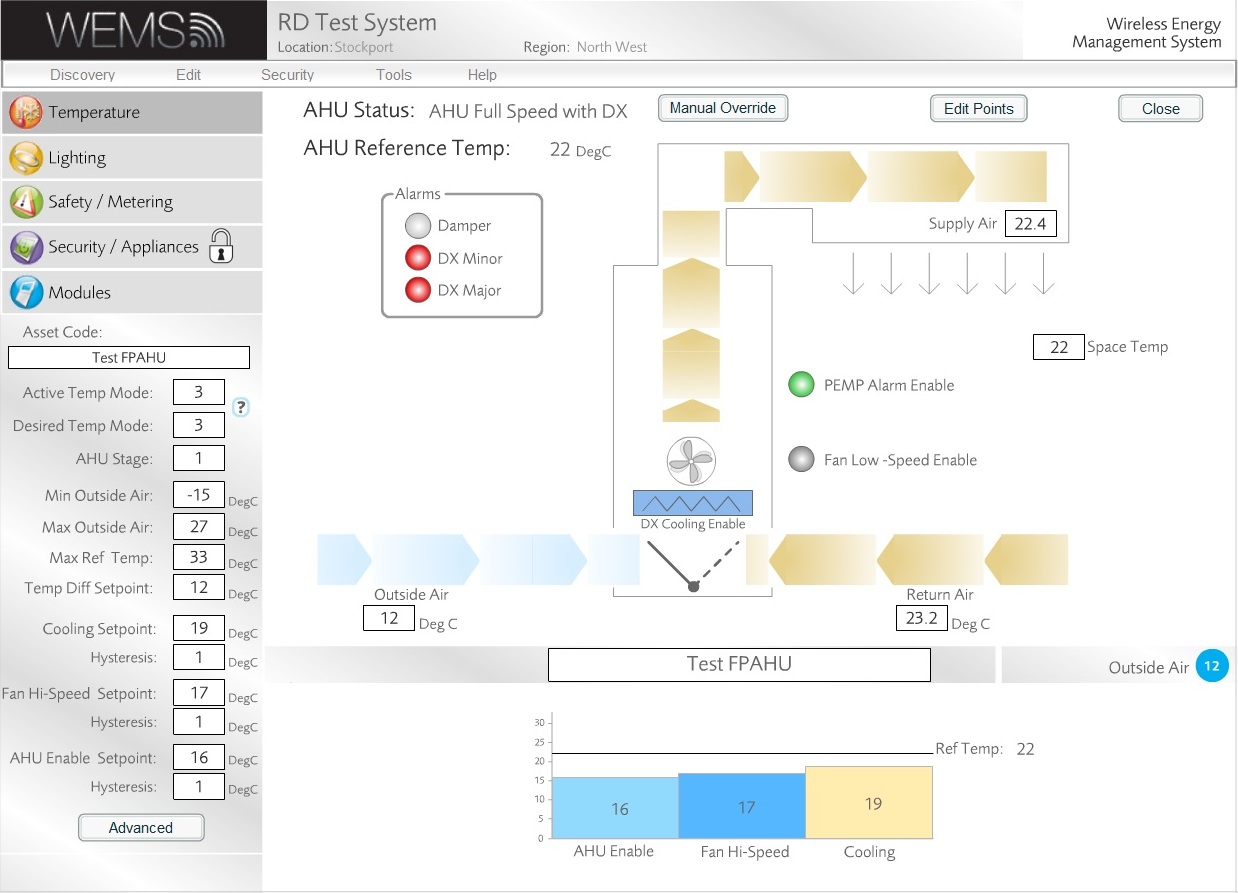
DX Major alarm
Advanced Settings
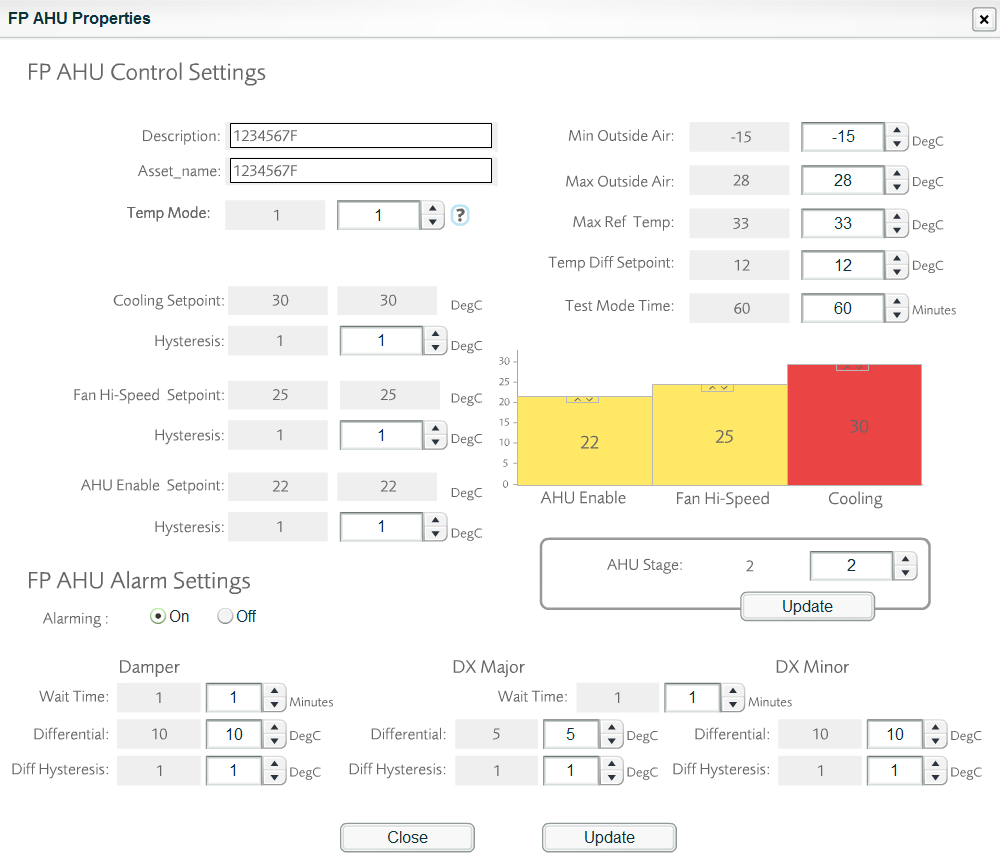
FP AHU Advanced Panel
The Advanced Panel is where numerous settings can be changed or tweaked to improve energy performance, modify the damper and DX Alarms, and much more.
The Advanced Panel always requires a password to make changes, which is explained in the FP AHU Control Strategy Advanced document (PDF) which runs through each point individually.
FP AHU Control Strategy Advanced
For a more detailed breakdown of the FP AHU control strategy, see the document below.
FP AHU Control Strategy Advanced (opens in a new window)